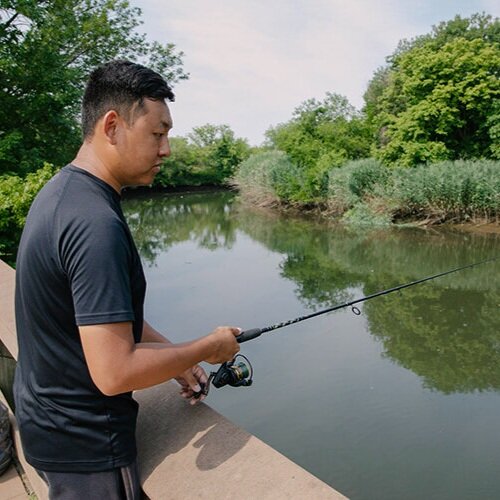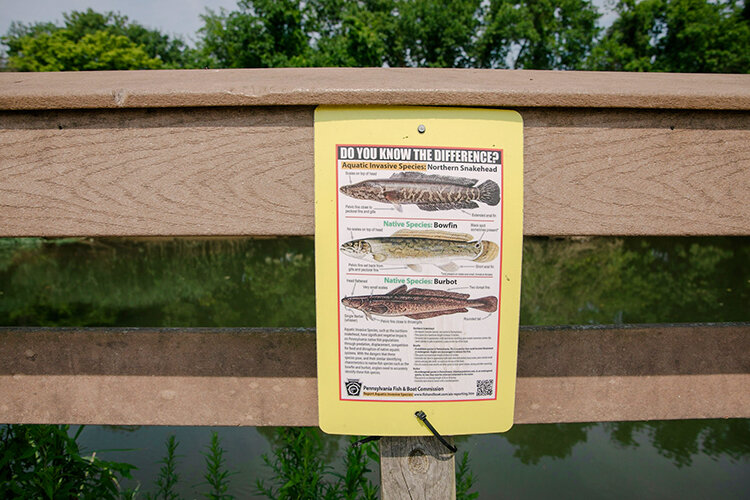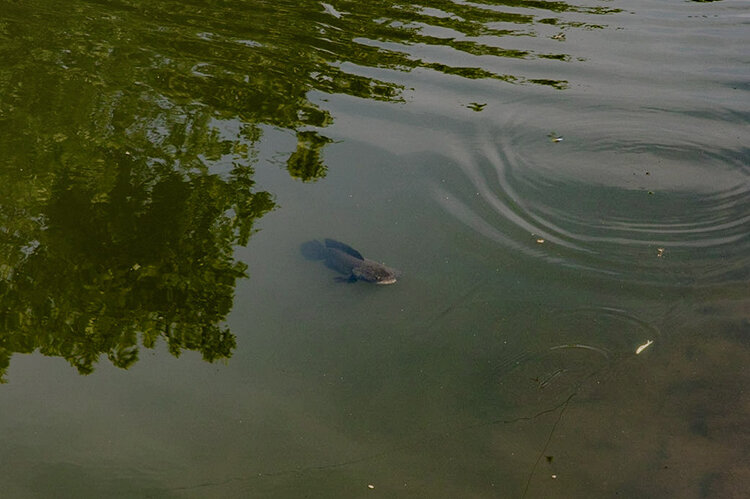I stood on the bank at the John Heinz National Wildlife Refuge at Tinicum in June and cast my green frog top lure out into an open patch of water amid the weeds knowing somewhere in there swam northern snakeheads.
Twenty years ago, they probably didn’t. The northern snakehead, or Channa argus, hails from East Asia and is relatively new to Mid-Atlantic waters. They are long-bodied fish with a brown reticulated pattern reminiscent of a python. In the right light and from the right angle, they look quite handsome. Zoom in on the wide, toothy mouth with its thuggish underbite, and they look like a fish you wouldn’t want to meet in a dark alley.
Hence the moniker “Frankenfish.” In 2002 the northern snakehead burst onto newspapers across the country with its discovery in a pond in Crofton, Maryland. Snakeheads can breathe air when there isn’t enough oxygen in the shallow, still water they prefer, and they can wriggle over land for short distances, helping them spread to new waters. These are big fish, getting to about three feet long, and as exotic predators they spurred fears that they could negatively impact aquatic ecosystems.
“… I know I’m helping the ecosystem by taking that animal even though I certainly don’t enjoy killing anything.”
— Sean Hartzell, aquatic invasive species coordinator at Pennsylvania Fish and Boat Commission
The result was not just a blizzard of news coverage, but at least three B movies: “Swarm of the Snakehead,” “Snakehead Terror,” and, most famous, “Frankenfish.”

Eventually the media storm died down, but the fish kept spreading. They were found in the Potomac River in 2004, and around the same time in the Philly area, including at FDR Park. They make good eating, and they were possibly introduced by anglers hoping to establish neighborhood populations.
“It’s a really tough critter to manage, unfortunately,” says Sean Hartzell, aquatic invasive species coordinator with the Pennsylvania Fish and Boat Commission. “They get established quickly. They travel.”
Today they swim in at least 15 states and as far up the Delaware River as the Delaware Water Gap.
Hartzell says that when they get reports of snakeheads in a new body of water, they try to remove them. That can work in smaller ponds, but in bigger bodies of water snakeheads are nearly impossible to get rid of once they get established. It is hard to kill all of them without killing every other fish. Even if it was possible, most of our waterways are interconnected, meaning new snakeheads will move right in.
PA Fish and Boat relies on anglers to do much of the snakehead control. It is illegal to introduce a snakehead into Pennsylvania waters or possess one alive. Anyone who catches a snakehead is thus required to kill it. (Hartzell was careful to point out that two native fish, burbots and bowfins, resemble snakeheads and that anglers should learn the differences before killing anything). New Jersey also requires anglers to kill any snakeheads they catch.
These rules run headlong into the deeply ingrained catch-and-release tradition.
“I’m an angler myself,” Hartzell says. “I release the fish that I catch. But if I catch a snakehead, I know I’m helping the ecosystem by taking that animal even though I certainly don’t enjoy killing anything.”
Not all anglers agree.
“When it comes to the snakehead community, there are definitely two sides to it,” says Leo Sheng, of the popular YouTube channel “Extreme Philly Fishing.”
“There are the people who want it to be the next sport fish,” he explains, and there are those, more-focused on conservation, who are deeply committed to killing every snakehead they catch.
Sheng says he always kills invasive fish species when he catches them in an isolated body of water or when the local land managers require it, for example at the John Heinz Refuge. But he isn’t so consistent when he fishes other open bodies of water, where, as he sees it, any fish he kills will be replaced by another moving in.
Meanwhile, Neaven Reevey (@boomerang_fisher on Instagram) says he releases the snakeheads he catches.
“I wasn’t raised to kill something I’m not going to eat,” he says. “I know they’re not native, but to me it’s still a living thing. It deserves a chance.”
Both Reevey and Sheng pointed out that plenty of other exotic fish like smallmouth bass, largemouth bass and channel catfish, are embraced by authorities. Rainbow trout, native to rivers draining into the Pacific Ocean, and the European brown trout are raised in hatcheries and stocked for fishers to catch.
Several of these widely accepted exotic fish have caused ecological problems of their own. For example largemouth bass have been implicated in declines of bridle shiners, a kind of minnow, in New England. Trout introduced to lakes in California’s Sierra Nevadas have caused declines in native frogs and other wildlife.
In the Chesapeake Bay watershed, where snakeheads have been established the longest, it seems that their impact has varied. In the Potomac River they may be coexisting with the other fish without a negative impact, according to a researcher there. However, a study in the Blackwater River on Maryland’s Eastern Shore looked at the fish community before and after snakeheads moved in. Researchers were unable to find two species of killifish, small fish that snakeheads often eat, and a third also declined.
It remains unclear what kind of impact snakeheads will have in our region, leaving a fishing community mixed on what to do with them.
I, for one, prepared myself to kill any that took my frog lure as I cast it into the weedy shallows, an act that wouldn’t come easy to this longtime vegetarian. Lucky for the fish, and perhaps lucky for me, nothing bit.









